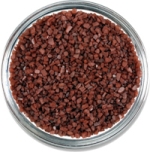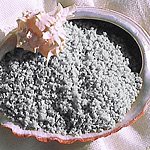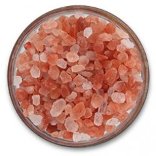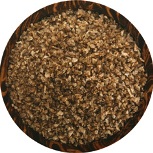Salt . . . the only rock we eat.
The natural salts of the sea – both past and present – vary a great deal in taste. Some are “salty” and dissolve quickly in the mouth – like Murray River salt from Australia; others are comparatively mild like the sea salts from France and El Salvador. Still others take a long time to dissolve but still deliver a wallop of flavor like the rose-colored “sea salts” from Tibet and Northern Pakistan.
In addition to salts that get their flavors from the mineral content, or the type of rocks surrounding their deposits, there are a whole host of “flavored” sea salts. Humans have infused flavors into these salts by deliberately smoking, soaking or otherwise exposing the natural salt to particular flavors. Some flavored salts include Black Salt from Cyprus (not to be confused with “black salt” from subcontinental cooking – which is not sodium chloride at all), salts flavored with garlic, onion or lime, or salts smoked with different woods, such as applewood or alderwood.
Some sea salts are just for “finishing” dishes, or for use with a light touch just before serving to impart a particular flavor. The flavored seas salts are great for this but nearly any seas salt can be used in this manner. Other sea salts that are great for finishing are the colorful ones – particularly if they are used on dishes that are very different in color from the salt to emphasize the contrast in colors. Other sea salts are good for cooking, finishing and table use. Those not needing grinding include Mayan Sun Salt and the French Fleur de Sels. Those salts requiring grinding are Tibetan Rose Salt and Peruvian Rose Salt.
Natural Sea Salts
 Cyprus Black Salt: This sea salt gets is distinctive black color from the addition of activated charcoal to the naturally harvested salt. Like Murray River, it has a flaky crystal structure that leads it to dissolve quickly in the mouth. Unlike Murray River, however, it has a gentler flavor and a bit of a crunch. The addition of charcoal lends mild detoxifying properties to this salt as well. I like Cyprus black salt or other black sea salts primarily for its color and use it on occasion as a finishing salt.
Cyprus Black Salt: This sea salt gets is distinctive black color from the addition of activated charcoal to the naturally harvested salt. Like Murray River, it has a flaky crystal structure that leads it to dissolve quickly in the mouth. Unlike Murray River, however, it has a gentler flavor and a bit of a crunch. The addition of charcoal lends mild detoxifying properties to this salt as well. I like Cyprus black salt or other black sea salts primarily for its color and use it on occasion as a finishing salt.
Murray River Salt – Australia: This salt is produced from the underground brines in the Murray Darling Basin in New South Wales. Its flaky, small crystals are a very light peachy color that is provided by carotene by-product from the algae in the river basin. For me the distinctive aspects of Murray River salt is the high speed at which it dissolves on the tongue and the sharpness of the flavor.
 Hawaiian Red Salt – United States: This colorful salt is the traditional salt of Hawaiian natives and ranges from dark pink to dark red in color depending on the amount of red clay added to the harvested salt. The red is imparted from the iron oxide in the clay. I find that this sea salt dissolves fairly quickly and like Murray River gives a strong salty flavor to food. Great as a finishing salt for its color.
Hawaiian Red Salt – United States: This colorful salt is the traditional salt of Hawaiian natives and ranges from dark pink to dark red in color depending on the amount of red clay added to the harvested salt. The red is imparted from the iron oxide in the clay. I find that this sea salt dissolves fairly quickly and like Murray River gives a strong salty flavor to food. Great as a finishing salt for its color.
Mayan Sun Salt – El Salvador: This sea salt is harvested by capturing and evaporating ocean water in man-made pools built into a mangrove forest. The volcanic soils in the forest give this salt a high mineral content. These mangrove sanctuaries are nurtured by mineral-rich volcanic soil. Pure ocean water is captured in the salt, imparting great flavor and high mineral content. It is generally unrefined or minimally processed. I find Mayan Sun to be the mildest of sea salts, with a gentle, purely salty flavor. It is my favorite of the smaller crystal salts.
 Fleur de Sel – France: Harvested off the French coast, originally in Brittany, this salt ranges in color from white to light pink to grey, depending on the sand and algae content in the harvested product. Salts marketed as “Brittany Grey” are just a type of Fleur de Sel harvested with a higher sand content than other salts, with the grey from the sand coloring the salt as it dried. It is produced by skimming the very top layer of salt ponds – so is in some respects a first pressing or an “extra virgin” product with a high mineral content including calcium and magnesium. I find the Fleur de Sel salts to add a mild, salty flavor to dishes and to take a while to dissolve due to its irregular crystal structure.
Fleur de Sel – France: Harvested off the French coast, originally in Brittany, this salt ranges in color from white to light pink to grey, depending on the sand and algae content in the harvested product. Salts marketed as “Brittany Grey” are just a type of Fleur de Sel harvested with a higher sand content than other salts, with the grey from the sand coloring the salt as it dried. It is produced by skimming the very top layer of salt ponds – so is in some respects a first pressing or an “extra virgin” product with a high mineral content including calcium and magnesium. I find the Fleur de Sel salts to add a mild, salty flavor to dishes and to take a while to dissolve due to its irregular crystal structure.
Southern Italian Sea Salt – Italy: This salt has been harvested directly from the coastal seas off of Southern Italy for more than 2000 years. It is a snowy white, medium to large crystal salt that takes time to dissolve on food or on the tongue. It is also high in mineral content – especially magnesium. For me this is a moderately salty sea salt. I sometimes serve it at the table in antique salt dishes with tiny spoons for a charming presentation.
Peruvian Rose Sea Salt – Peru: Contrary to its name, this salt is not gathered from the sea, but from dried salt beds in the foothills of the Peruvian Andes. It is tan to light pink in color and has medium to large crystals that also dissolve slowly.
 Tibetan Rose Salt – Tibet to Pakistan: Like Peruvian Rose Salt, this salt is harvested from dried salt beds and underground deposits in the Himalayan mountains and foothills that formed in the Jurassic period when dinosaurs ruled the earth. It has large, jewel-like, dark pink crystals that dissolve very slowly and produce a strong salty flavor across the whole mouth. Tibetan rose is my favorite large crystal salt because, although salty, it isn’t sharp or overwhelming. Suitable for cooking, finishing or as a table salt. Best if ground just before use.
Tibetan Rose Salt – Tibet to Pakistan: Like Peruvian Rose Salt, this salt is harvested from dried salt beds and underground deposits in the Himalayan mountains and foothills that formed in the Jurassic period when dinosaurs ruled the earth. It has large, jewel-like, dark pink crystals that dissolve very slowly and produce a strong salty flavor across the whole mouth. Tibetan rose is my favorite large crystal salt because, although salty, it isn’t sharp or overwhelming. Suitable for cooking, finishing or as a table salt. Best if ground just before use.
Flavored Sea Salts
Onion and Garlic Sea Salts: These flavored sea salts are gourmet versions of the dried garlic and onion salt seasonings found in nearly every cupboard of the last generation of western cooks. The flavor is stronger than your mom’s garlic salt or onion salt, but more distinct is the medium crystal size and generally high moisture content from lack of processing and lack of addition of desiccating agents and flow-enhancers. Good for use as finishing salts on roasts and other meats.
Lime Sea Salt: The classic salt for the crust around the edge of a margarita glass, its strong lime flavor also works as a finishing salt for dishes or salads to enhance a lime or citrus flavor.
Rosemary Sea Salt: One representative of a whole family of herbed sea salts, this is another smaller crystal salt enhanced with rosemary flavor that is best used as a finishing salt.
 Applewood Smoked Salt: This salt has a strong smoky flavor that works great as a finishing salt for roasts and meats of all types to impart a deep, lightly smoky flavor. More smoke than salt, in my opinion.
Applewood Smoked Salt: This salt has a strong smoky flavor that works great as a finishing salt for roasts and meats of all types to impart a deep, lightly smoky flavor. More smoke than salt, in my opinion.
_________
There is a whole world of flavor, texture and dissolution speed to be had in seas salts that are absent from processed, chemical laden concoction we call table salt. Except for the addition of iodine in table salt – which helps decrease cretinism and goiter – sea salt is far more healthy for you as well because of its higher trace mineral content that usually includes magnesium and calcium.
I recommend experimenting with them to find the salts you like the best or will use on a regular basis. One way to do this is to buy one of the many samplers of sea salt available on the market and tasting each one on a small bit of neutrally flavored cracker with butter or a gently-flavored vegetable like a cucumber. Go ahead, have fun experimenting with flavors and discover something new about salt – remember, salt is the only rock we eat. (Words by Laura Kelley, Photographs of Sea Salts borrowed from Google images.)
